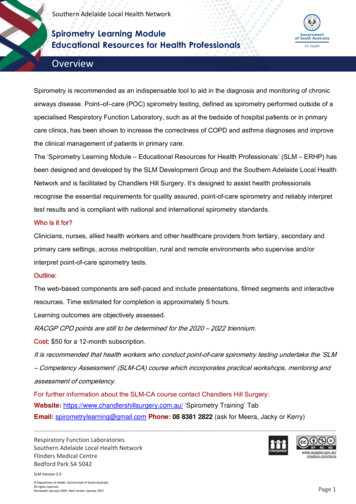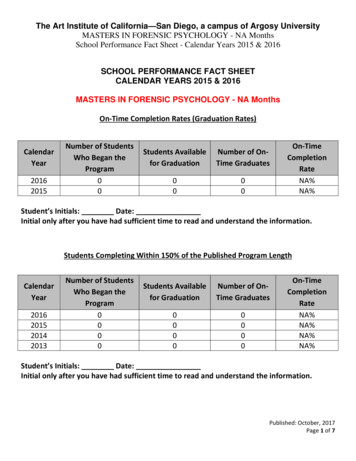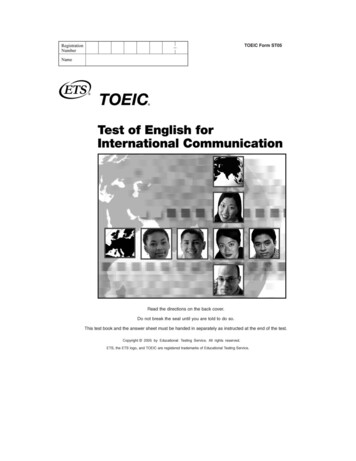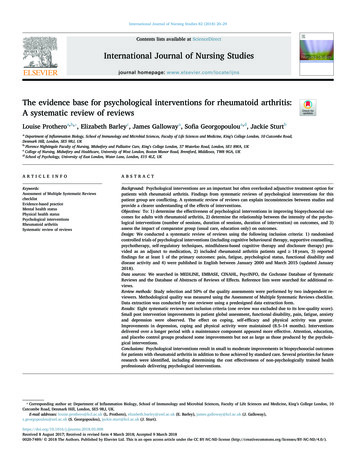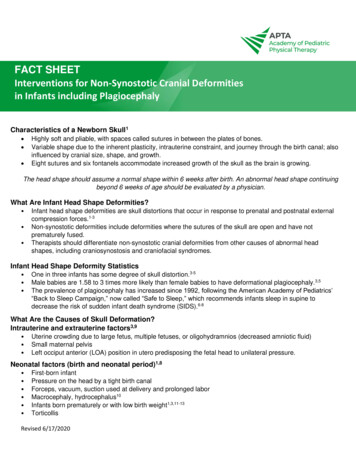
Transcription
FACT SHEETInterventions for Non-Synostotic Cranial Deformitiesin Infants including PlagiocephalyCharacteristics of a Newborn Skull1 Highly soft and pliable, with spaces called sutures in between the plates of bones.Variable shape due to the inherent plasticity, intrauterine constraint, and journey through the birth canal; alsoinfluenced by cranial size, shape, and growth.Eight sutures and six fontanels accommodate increased growth of the skull as the brain is growing.The head shape should assume a normal shape within 6 weeks after birth. An abnormal head shape continuingbeyond 6 weeks of age should be evaluated by a physician.What Are Infant Head Shape Deformities? Infant head shape deformities are skull distortions that occur in response to prenatal and postnatal externalcompression forces.1-3Non-synostotic deformities include deformities where the sutures of the skull are open and have notprematurely fused.Therapists should differentiate non-synostotic cranial deformities from other causes of abnormal headshapes, including craniosynostosis and craniofacial syndromes.Infant Head Shape Deformity Statistics One in three infants has some degree of skull distortion.3-5Male babies are 1.58 to 3 times more likely than female babies to have deformational plagiocephaly.3,5The prevalence of plagiocephaly has increased since 1992, following the American Academy of Pediatrics’“Back to Sleep Campaign,” now called “Safe to Sleep,” which recommends infants sleep in supine todecrease the risk of sudden infant death syndrome (SIDS).6-8What Are the Causes of Skull Deformation?Intrauterine and extrauterine factors3,9 Uterine crowding due to large fetus, multiple fetuses, or oligohydramnios (decreased amniotic fluid)Small maternal pelvisLeft occiput anterior (LOA) position in utero predisposing the fetal head to unilateral pressure.Neonatal factors (birth and neonatal period)1,8 First-born infantPressure on the head by a tight birth canalForceps, vacuum, suction used at delivery and prolonged laborMacrocephaly, hydrocephalus10Infants born prematurely or with low birth weight1,3,11-13TorticollisRevised 6/17/2020
Skull shape deformations that occur after birth or progressHypotonic infants presenting with weak neck muscles14Congenital hip and spine problems15Environmental factors7 Preference to turn head to one side while sleeping due to crib/sleep surface positionSleeping and playing in the supine position with very little or no time spent in prone1,4,14Excess time spent in infant carriers, car seats, and strollers6,16Prolonged placement in one position in the neonatal intensive care unit (NICU)13,17Prolonged position secondary to medical and orthopedic treatments (Ex. Feeding tube, ventilation, Pavlikharness)11,13,17What Are the Types of Skull niosynostosis Premature closure of one or more sutures of the skull.Clinical presentation of the skull is dependent on the suture(s) involved:sagittal, metopic, coronal, and lambdoid.o Lambdoid synostosis is least common18; mistaken for plagiocephaly.Suspicion of craniosynostosis requires referral back to pediatrician forevaluation by a pediatric neurosurgeon or craniofacial physician.10Most infants require surgical intervention to open prematurely closed sutures.Non-synostoticPlagiocephaly BrachycephalyRevised 6/17/2020 Unilateral occipital flattening, anterior progression of the ear on the same sideas the flattened occiput, varying degrees of ipsilateral frontal and contralateralposterior parietal bossing (parallelogram shape).Cranial Vault Asymmetry (CVA) is assessed by measuring the longest andshortest diagonals of the skull and subtracting the difference in millimeters.19Severe cases can involve the eyes, cheeks, and jaw.5Associated with congenital muscular torticollis, congenital hip dislocation, andcongenital scoliosis.15Right occipital flattening more common than left occipital flattening (2:1).3-5Severity is determined by the number of skull quadrants involved in thedeformity with or without the presence of facial and jaw asymmetry.Skull is disproportionately wide compared to its lengthProminent or bossed foreheadIncreased height of the cranial vaultCentral occipital flatteningSeverity is determined by the number of deviations above the mean forCephalic Index (CI), increased vertex height, and frontal involvement of theforehead and facial structures. CI (Width/Length) x 100.19 CI is higher for infants who sleep supine and spend extended time insupine. The mean CI is 79% to 84% depending on age and gender of the infant.19
TypeCharacteristicsNon-synostotic (Continued)AsymmetricalBrachycephaly Combination deformity is characterized by disproportion and asymmetry.Severity is determined by the number of asymmetrical skull quadrants and thedegree of disproportion.Scaphocephaly(Dolichocephaly) Disproportionately long skull for its width. 75% of neonates born preterm ( 32 weeks post-menstrual age) present withsome degree of dolichocephaly at term age12Shape common in babies who spend extended time in NICU or are positionedside-lying.Sagittal Craniosynostosis can also present with a Scaphocephalic headshape. In the absence of a NICU history or excessive side positioning,craniosynostosis should be ruled out by a craniofacial specialist.Severity determined by the number of deviations below the mean for CephalicIndex (CI).o CI (Width/Length) x 100.11,19 Photos provided courtesy OrthomericaHow Can Skull Symmetry Be Promoted?16Early caregiver education, diagnosis, treatment, and counseling are important following the infant’s birth when theskull is most susceptible to deformation.First Choice Interventions:(Infants 0 – 4 months of age without torticollis, developmental concerns, or obvious skull deformities)Parent Education, Repositioning, and Exercises6,7,16,20Goal: Shift infant off flattened areas to encourage a symmetrical head shape and promote typical development. Alternate the head position in supine (right cheek on surface one time, left cheek next). When awake and supervised, prop the baby onto one side with a foam wedge or a towel rolled lengthwisealong the baby’s back. Conduct supervised “tummy time” in the waking hours to improve the baby’s muscle strength,development, and keep the pressure baby off the back of the head. Watch for “high guard,” “touch down” positioning of the arms and ensure that the infant has opportunitiesfor midline play. Limit time in car seats, infant seats, swings, and strollers. Frequently change the position of the crib or the orientation of the baby in the crib to reduce the baby’stendency to look in the same direction.Revised 6/17/2020
Change positions when feeding, carrying, and holding the baby.Provide supervised upright play as soon as the baby has upright head control.Interact with the baby from different sides, during feeding, changing, and playing.Encourage side-lying play opposite the flat side of the head.Request referral for physical therapy or cranial remolding orthosis evaluations, if the infant demonstratesresistance to repositioning, neck tightness, movement asymmetries, or if the head shape worsens or doesnot improve with the repositioning and exercises.Second Choice Interventions:Cranial Remolding Treatment8Goal: Encourage symmetrical and proportionate skull growth through the use of a custom, Cranial RemoldingOrthosis (CRO.) Provide total contact over the abnormally prominent areas of the skull. Direct growth into the areas of void within the CRO where growth is desirable. Initiate treatment within the first year of life when the skull is rapidly growing.All cranial orthoses require FDA clearance; Photos provided courtesy of OrthomericaIndications: Babies 3-18 months with moderate to severe head shape deformities with symmetrical movements and notorticollis No response or poor response to repositioning therapy Secondary changes to the skull or frontal facial asymmetries Babies with persistent skull deformity after a repositioning programContraindications to Cranial Remolding Orthosis: Craniosynostosis Unresolved hydrocephalus Children beyond 18 months of corrected age Babies under 3 months of corrected ageCranial Remolding Treatment Considerations (helmets and bands)8,16 Age at beginning of treatment, type and severity of deformation, and caregiver adherence with thetreatment program all affect treatment. Factors include:o Average age range for initiating treatment is 4 to 12 months.o Overall age range for treatment is 3 to 18 months.o Optimum age range for initiating treatment is 4 to 6 months.o Cranial remolding orthosis is worn 23 hours per day for a period of 3 to 6 months.o Follow up is 1-2 weeks after the initial fit and every 2-3 weeks thereafter.o Request referral for Physical Therapy evaluation if torticollis, movement asymmetries or developmentaldelays are observed.Revised 6/17/2020
Physical Therapy Treatment20Goals: Resolve range of motion deficits, promote age-appropriate motor skill development, strengthen weakmuscle groups, provide a home handling/positioning program, and promote resolution of the head shape deformityas a result of the therapeutic interventions. Request referral for cranial remolding treatment if the head shape doesnot resolve with physical therapy interventions only.Indications: Restricted neck and shoulder range of motion Presence of torticollis Delay in gross and fine motor skills Lack of head shape improvement after 1 month of caregiver repositioning/handling/tummy time Babies 0-12 months with minimal head shape deformities and asymmetrical movement preferences Babies 0-4 months with moderate to severe head shape deformities and asymmetrical movementpreferencesCranial Remolding Treatment and Physical TherapySince congenital muscular torticollis and non-synostotic cranial deformities often have similar etiology andenvironmental factors, concurrent treatment of cranial remolding treatment and PT can enhance outcomes.Goal: Coordination of the infant’s care through collaborative communication between the caregivers, physician(s),and treating clinicians to include: Treatment plans Infant’s progress Caregivers compliance Factors that may impact treatments Discharge and follow-up planningThird Choice Interventions:Surgery for non-synostotic cranial deformities18Indications: Rare in in infants with head shape deformities without synostosis Used in very severe deformities resistant to non-surgical measures10Cited References:1. Aarnivala H, Vuollo V, Harila V, et al. The course of positional cranial deformation from 3 to 12 months of age andassociated risk factors: a follow-up with 3D imaging. Eur J Pediatr. 2016;175(12):1893-1903.2. Aihara Y, Komatsu K et al. Cranial molding helmet therapy and establishment of practical criteria for management inAsian infant positional head deformity. Childs Nerv System; 2014 Sep;30(9):1499-1509.3. Peitsch WK, Keefer CH, LaBrie RA, Mulliken JB. Incidence of cranial asymmetry in healthy newborns. Pediatrics.2002;110:1-8.4. Bellardini E, Cisti M, Basagila N, et al. Prevalence and characteristics of positional plagiocephaly in healthy full-terminfants at 8-12 weeks of life. Eur J Pediatr. 2018;177:1547-1554.5. Leung A, Madrusiak A et al. Clinical assessment of head orientation profile development and its relationship to positionalplagiocephaly in healthy term infants—a prospective study. Early Human Dev. 2016;96:31–38.6. American Academy of Pediatrics Task Force on Sudden Infant Death Syndrome. SIDS and Other Sleep-Related InfantDeaths: Updated 2016 Recommendations for a Safe Infant Sleeping Environment. Pediatrics. 2016;138(5):e201629387. Ditthakasem K, Kolar J. Deformational plagiocephaly: A review. Pediatr Nurs. 2017;43(2):59-64.8. Graham T, Adams-Huet B et al. Effects of initial age and severity on cranial remolding orthotic treatment for infants withdeformational plagiocephaly. J Clin Med. 2019;8(8). pii: E1097.9. Littlefield TR, Kelly KM, Pomatto JK, Beals SP. Multiple-birth infants at higher risk for development of deformitationalplagiocephaly: II. Is one twin at greater risk? Pediatrics. 2002;109(1):19-25.10. Fenton R, Gaetani SA. A pediatric epidemic Deformational plagiocephaly/ brachycephaly and congenital musculartorticollis. Contemporary Pediatrics. 2019;36(2):10-18.Revised 6/17/2020
11. Ifflaender S, Rüdiger M et al. Prevalence of head deformity in pre-term infants at term-equivalent. Early Hum Dev.2013;89(12):1041-7.12. McCarty DB, Peat JR, Malcom WF, Smith B, Fisher K, Goldstein RF. Dolichocephaly in Preterm Infants: Prevalence, RiskFactors, and Early Motor Outcomes. American Journal of Perinatology. 2016; 34(4):372-378.13. Nuysink J, Eijsermans MJ et al. Clinical course of asymmetric motor performance and deformational plagiocephaly in verypreterm infants. J Pediatr. 2013;163(3):658-65.14. Hutchison BL, Stewart AW, Mitchell EA. Characteristics, head shape measurements and developmental delay in 287consecutive infants attending a plagiocephaly clinic. Acta Pediatrica. 2009; 98:1494-1499.15. Talmage MS, Nielson AN et al. Prevalence of hip dysplasia and associated conditions in children treated for idiopathicearly-onset scoliosis—don’t just look at the spine. J Pediatr Orthopedics. 2020;40(1):e49-e52.16. Naidoo SD, Skolnick GB et al. Long-term outcomes in treatment of deformational plagiocephaly and brachycephaly usinghelmet therapy and repositioning: a longitudinal cohort study. Childs Nerv Syst. 2015;31:1547-1552.17. Danner-Bowman K, Cardin AD. Neuroprotective Core Measure 3: Positioning & Handling — A Look at PreventingPositional Plagiocephaly. Newborn and Infant Nursing Reviews. 2015;15(3):111-11318. Dempsey RF, Monson LA et al. Nonsyndromic craniosynostosis. Clin Plastic Surg. 2019;46(2):123-139.19. Wilbrand JF, Schmidtberg K et al. Clinical classification of infant nonsynostotic cranial deformity. J Pediatr.2012;161(6):1120-5.20. Cevik S, Isik S et al. The role of age on helmet therapy in deformational plagiocephaly and asymmetric brachycephaly.Childs Nervous System. 2020;36(4):803-810.Supplementary References1. Aarnivala H, Vuollo V, Harila V, et al. Preventing deformational plagiocephaly through parent guidance: a randomizedcontrolled trial. Eur J Pediatr. 2015;174:1197–1208.2. Academy of Pediatric Physical Therapy. Congenital Muscular Torticollis Clinical Practice Guideline ImplementationResources. 2018. Available at: https://pediatricapta.org/clinical practice guidelines/3. Academy of Pediatric Physical Therapy. User Guide: How to Use 2018 Congenital Muscular Torticollis Clinical PracticeGuideline Discharge Guide. 2018. Available nload/?document id d79bd460-e158-11e8-ac38-005056a04e374. Academy of Pediatric Physical Therapy. 2018 CMT CPG Resource Packet for Parents and Caregivers. 2018. Availableat: ad/?document id be667c76-e158-11e8-ac38-005056a04e375. Andrews BT, Fontana S. Correlative versus causative relationship between neonatal head shape anomalies and earlydevelopmental delays. Frontiers Neurosci. 2017. Available at: https://doi.org/10.3389/fnins.2017.007086. Baird LC, Klimo P, Flannery AM., et al. Congress of Neurological Surgeons systematic review and evidence-basedguideline on the management of patients with positional plagiocephaly: The role of physical therapy. Neurosurg.2016;79(5):E630-E631.7. Cabrera-Martos, Valenza MC et al. Effects of manual therapy on treatment duration and motor development on infantswith severe nonsynostotic plagiocephaly: a randomized controlled pilot study. Childs Nerv Syst. 2016;32(11):2211-2217.8. Cabrera-Martos I, Valenza MC et al. Repercussions of plagiocephaly on posture, muscle flexibility and balance inchildren aged 3-5 years old. J Paediatr Child Health. 2016;52(5):541-6.9. Cabrera-Martos I, Valenza MC et al. Impact of torticollis associated with plagiocephaly on infants’ motor development. JCraniofac Surg. 2015;26(1):151-6.10. Cabrera-Martos I, Valenza MC et al. Clinical profile and evolution of infants with deformational plagiocephaly included ina conservative treatment program. Childs Nerv Syst. 2013;29:1893–1898.11. Collett BR, Gray KE, Starr JR, Heike CL, Cunningham ML, Speltz ML. Development at age 36 months in children withdeformational plagiocephaly. Pediatrics. 2013;131(1):e109-15.12. Collett BR, Heike CL et al. Longitudinal, three-dimensional analysis of head shape in children with and withoutdeformational plagiocephaly or brachycephaly. J Pediatrics. 2012;160(4):673-678.e113. Collett BR, Wallace ER. Infant/toddler motor skills as predictors of cognition and language in children with and withoutpositional skull deformation. Childs Nervous System. 2019 Jan;35(1):157-163.14. Collett BR, Wallace ER, Kartin D, Cunningham ML, Speltz ML. Cognitive outcomes and positional plagiocephaly.Pediatrics. 2019; 143(2) e20182373.15. Dorhage KW, Beck-Broichsitter BE et al. Therapy effects of head orthoses in positional plagiocephaly. J CraniomaxillofacSurg. 2016;44(10):1508-1514.16. Dorhage K, Wiltfang J et al. Effect of head orthosis on skull deformities in positional plagiocephaly: evaluation of a threedimensional approach. J CranioMaxillofac Surgy. 2018;46(6):953-957.Revised 6/17/2020
17. Eberle NA, Stelnicki EJ et al. Efficacy of conservative and cranial orthotic therapy in over 4000 patients treated forpositional plagiocephaly over a 5 year period. Plastic Reconstructive Surg. 2015;136(4S):5-6.18. Fenton R, Gaetani S et al. Description of mandibular improvements in a series of infants with congenital musculartorticollis and deformational plagiocephaly treated with physical therapy. Cleft Palate Craniofac J. 2018;55(9):1282-1288.19. Fish D, Lima D et al. Cranial remolding orthoses. In: Webster J, Murphy D (Eds). Atlas of Orthoses and AssistedDevices. 5th Edition. Elsevier: Philadelphia, PA. 2018.20. Flannery AB, Looman WS et al. Evidence based care of the child with deformational plagiocephaly, part ii: management.J Pediatr Health Care. 2012;26(5):320-331.21. Fontana SC, Daniels D et al. Assessment of deformational plagiocephaly severity and neonatal developmental delay. JCraniofac Surg 2016;27(8):1934-1936.22. Fowler EA, Becker DB et al. Neurologic findings in infants with deformational plagiocephaly. J Child Neurol.2008;23(7):742-7.23. Freudisperger C, Steinmacher S et al. Impact of severity and therapy onset on helmet therapy in positionalplagiocephaly. J Craniomaxillofacial Surg. 2016;44:110-115.24. Goh JL, Bauer DF, Durham SR et al. Orthotic (helmet) therapy in the treatment of plagiocephaly. Neurosurg Focus.2013;35(4):E2.25. Graham JM, Kreutzman J, Earl D, Halberg A, Samayoa C, Guo X. Deformational brachycephaly in supine‐sleepinginfants. J Pediatr. 2005;146:253-257.26. Graham T, Gilbert N et al. Significant factors influencing the effectiveness of cranial remolding orthoses in infants withdeformational plagiocephaly. J Craniofacial Surg. 2019;30(6):1710-1713.27. Han M, Kang J et al. Relationship between starting age of cranial-remolding-orthosis therapy and effectiveness oftreatment in infants with deformational plagiocephaly. Childs Nerv Syst. 2017;33(8):1349-1356.28. Hautopp L, Wester S et al. Benefit of physiotherapeutic treatment in children with torticollis. Dan Med J.2014;61(12):A4970.29. Ho JPK, Mallitt KA et al. Use of external orthotic helmet therapy in positional plagiocephaly. J Clin Neurosci. 2016;29:4651.30. Howlowka M, Reisner A et al. Plagiocephaly severity scale to aid in clinical treatment recommendations. J CraniofacSurg. 2017;28(3):717-72231. Hussein M, Woo T et al. Analysis of the correlation between deformational plagiocephaly and neurodevelopmental delay.J Plast Reconstr Aesthetic Surg. 2018;71(1):112-117.32. Kane AA, Mitchell LE, Craven KP, Marsh JL. Observations on a recent increase in plagiocephaly without synostosis.Pediatrics. 1996;97(6):877-885.33. Kaplan S, Coulter C, and Sargent B. Physical therapy management of congenital muscular torticollis: a 2018 evidencebased clinical practice guideline from the APTA Academy of Pediatric Physical Therapy. Pediatr Phys Ther.2018;30:240–290. Available at: ad/?document id ef617417-e15011e8-ac38-005056a04e3734. Kelly KM, Joganic EF et al. Helmet treatment of infants with deformational brachycephaly. Global Pediatr Health.2018;5:2333794X18805618.35. Kennedy E, Majnemer A, Farmer JP, Barr RG, Platt RW. Motor development of infants with positional plagiocephaly.Phys Occup Ther Pediatr. 2009;29(3):222-235.36. Kilmo P, Lingo PR et al. Congress of Neurological Surgeons systematic review and evidence-based guidelines on themanagement of patients with positional plagiocephaly: the role of repositioning. Neurosurgery. 2016;79:e627-e629.37. Kluba S, Kraut W et al. What is the optimal time to start helmet therapy in positional plagiocephaly. Plast Reconstr Surg.2011;128(2):492-8.38. Kluba S, Robkopf. Malocclusion in the primary dentition in children with and without deformational plagiocephaly. ClinOral Investig. 2016;20(9):2395-2401.39. Knight S, Anderson VJ. Early neurodevelopment in infants with deformational plagiocephaly. J Craniofacial Surg.2013;24:4.40. Kordestani RK, Patel S, Bard DE, Gurwitch R, Panchal J. Neurodevelopmental delays in children with deformationalplagiocephaly. Plast Reconstr Surg. 2006;117:207-218.41. Kreutz M, Fitze B. Facial asymmetry correction with molded helmet therapy in infants with deformational skull baseplagiocephaly. J Craniomaxillofacial Surg. 2018;46:28-34.42. Levi B, Wan DC, Longaker MT & Habal MB. Deformational plagiocephaly: A look into the future. J Craniofac Surg.2011;22(1): 3-5.43. Linz C, Collmann et al. Occipital plagiocephaly: unilateral lambdoid synostosis versus positional plagiocephaly. Arch DisChild. 2014;100(2):1-6.44. Mawji A, Vollman AR et al. The incidence of positional plagiocephaly: a cohort study. Pediatrics. 2013;132(2):298-304.Revised 6/17/2020
45. Mawji A, Vollman AR et al. Risk factors for positional plagiocephaly and appropriate time frames for preventionmessaging. Paediatr Child Health 2014;19(80:423-427.46. Murgia M, Venditto T et al. Assessing the cervical range of motion in infants with positional plagiocephaly. J CraniofacSurg. 2016;27:1060-1064.47. Nitsos A, Estrada R et al. Tummy time for Latinos with limited English proficiency and feasibility of a cultural andlinguistically adapted parent education intervention. J Pediatric Nursing. 2017;36:31-36.48. Nuysink J. Supporting early development of infants with identified positional plagiocephaly. Phys Occup Ther Pediatr.2009;29(3): 236-8.49. Rogers GF. Deformational plagiocephaly, brachycephaly, and scaphocephaly. Part I:Terminology, diagnosis, andetiopathogenesis. J Craniofac Surg. 2011; 22(1):9 – 16.50. Rogers GF. Deformational plagiocephaly, brachycephaly, and scaphocephaly. Part II: Prevention and treatment. JCraniofac Surg 2011;22(1):9-117-23.51. Rogers GF, Oh AK & Mulliken JB. The role of congenital muscular torticollis in the development of deformationalplagiocephaly. Plast Reconstr Surg. 2009;123:643-652.52. Siatkowski RM, Fortney AC, Nazir SA, et al. Visual field defects in deformational posterior plagiocephaly. J AAPOS.2005;9:274 – 278.53. Siegenthaler MH. Methods to diagnose, classify and monitor infantile deformational plagiocephaly and brachycephaly: anarrative review. J Chiropractic Med. 2015;14:191–204.54. Speltz ML, Collett BR, Stott‐Miller M, et al. Deformational plagiocephaly delays motor skill development in 6‐month‐oldinfants. J Pediatr. 2010;157(3): 514-515.55. Steinbok P, Lam D. Long-term outcome of infants with positional plagiocephaly. Childs Nerv Syst. 2007;23:1275-1283.56. Steinberg JR, Rawlani R et al. Effectiveness of conservative therapy and helmet therapy for positional cranialdeformation. Plast Reconstr Surg. 2015;135:833-842.57. Tamber MS, Nikas D et al. Congress of Neurological Surgeons systematic review and evidence-based guideline on therole of cranial molding orthosis (helmet) therapy for patients with positional plagiocephaly. Neurosurgery. 2016;70:E632e633.58. van Vlimmeren L, Engelbert R et al. The course of skull deformation from birth to five years of age: a prospective cohortstudy. Eur J Pediatr. 2017;176:11-21.59. Watemberg N, Ben-Sasson A et al. Transient motor asymmetry among infants with congenital torticollis—description,characterization, and results of follow-up. Pediatr Neurology. 2016;59:36-40.60. Yu CC, Wong FH, et al. Craniofacial deformation in patients with uncorrected congenital muscular torticollis: Anassessment from three‐dimensional computed tomography imaging. Plast Reconstr Surg. 2004;113:24-33. 2020 by the APTA Academy of Pediatric Physical Therapy, American Physical Therapy Association,1020 N Fairfax St, Suite 400, Alexandria, VA 22314, www.pediatricapta.org.Supported by the Practice Committee of APTA Pediatrics, with special thanks to expert contributorsDulcey Lima OTR/L; Jessica Corso, CO, LO, FAAOP; Colleen P Coulter, PT, DPT, PhD, Board-CertifiedClinical Specialist in Pediatric Physical Therapy, Catie Christensen, PT, DPT, Board-Certified ClinicalSpecialist in Pediatric Physical Therapy, and Kim Lephart, PT, DPT, MBA, Board-Certified ClinicalSpecialist in Pediatric Physical Therapy.The APTA Academy of Pediatric Physical Therapy provides access to these member-produced factsheets and resources for informational purposes only. They are not intended to represent the positionof APTA Pediatrics or of the American Physical Therapy Association.Revised 6/17/2020
Early caregiver education, diagnosis, treatment, and counseling are important following the infant’s birth when the skull is most susceptible to deformation. First Choice Interventions: (Infants 0 – 4 months of age without torticollis, developmental concerns, or obvious skull deformities






